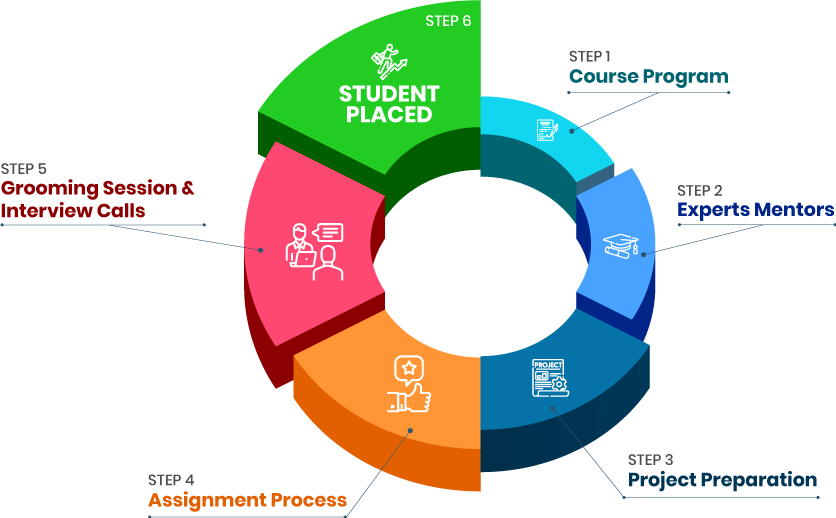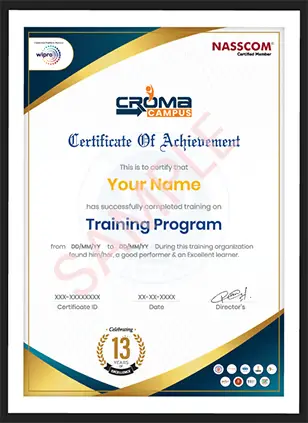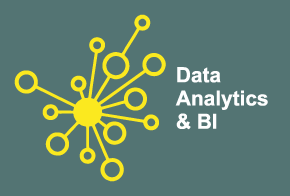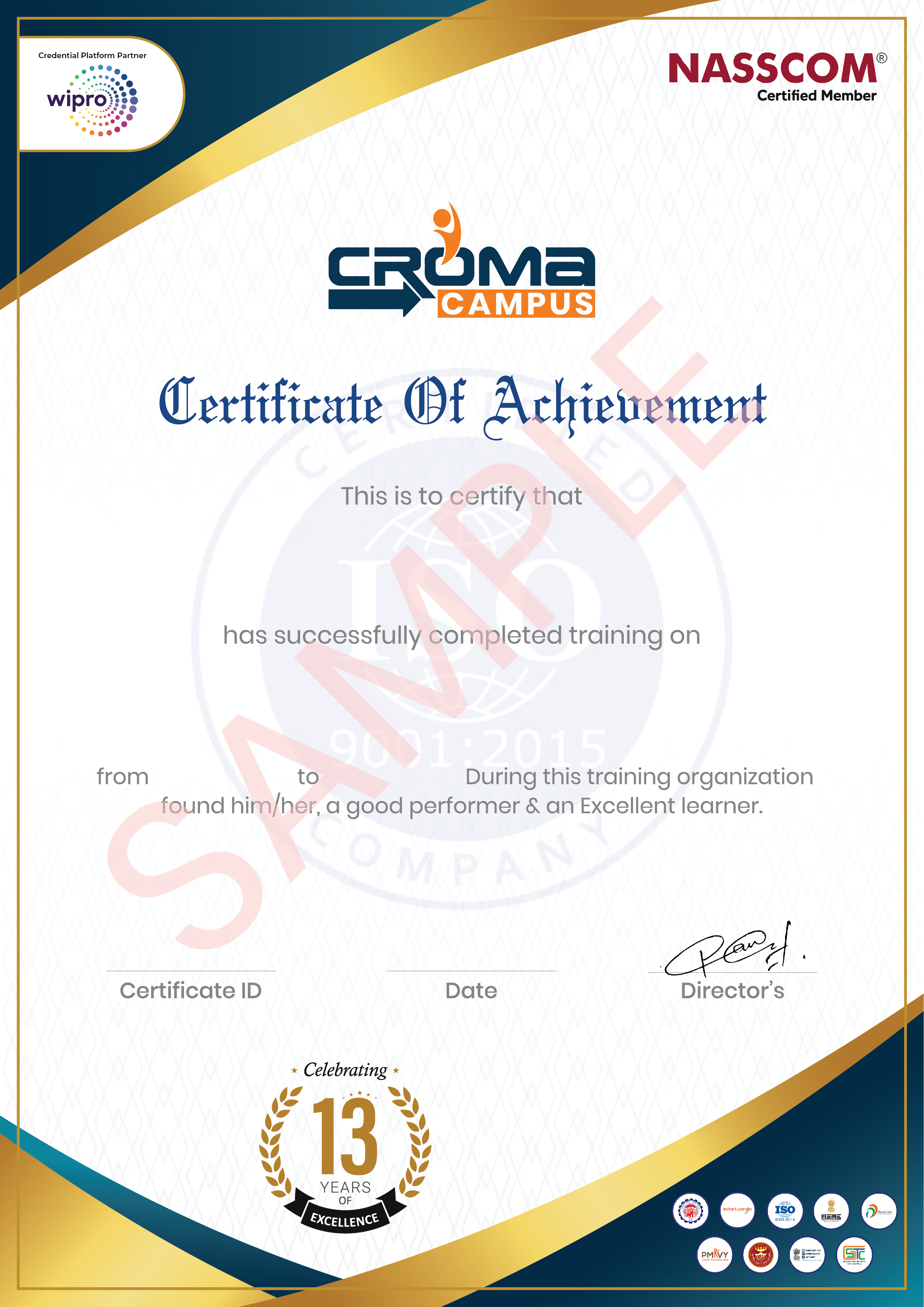- Nowadays, numerous businesses, both large and small, deal with massive data volumes, and loads depend on their ability to obtain meaningful insights from them. Moreover, a skilled Data Analyst performs precisely that. They are the ones who interpret statistical data and turn it into useful information that businesses can utilize for critical decision-making. If your interest also lies in this direction, you must take up the Data Analyst Course in Gurgaon and move forward in the right direction.
- To acquire its in-depth information, you can easily reach any well-established educational foundation. Well, one such well-setup institution is Croma Campus. Yes, it has been referred to as one of the best providers of Data Analyst Training Course in Gurgaon as it comprises a team of qualified faculty members that assist the candidates to know the whole functionality of this procedure in a detailed way.
- By enrolling in our Data Analyst Training in Gurgaon, you will get the chance to obtain some valuable information from various examples, study material, etc.
- Let us proceed further and know what you will cover in this course.
Right at the beginning of Data Analyst Course in Gurgaon:
You will get to know about its fundamentals & basics.
How to examine data and how to utilize statistics in practice, explain different behaviours and events, analyse, and create data for the analysis, and how to accumulate data respectively.
Data planning, data exploration, data collection, data analysis, etc.
Grasp details about the latest trends, information regarding handling data, and the whole procedure.
- Skilled and experienced Data Analysts are paid hugely well. So, if you are concerned about its salary slab, then do not bother, and get yourself enrolled in Data Analyst Training Course in Gurgaon to get started with this field immediately.
- To know the salary figures, refer to the points mentioned below.
A fresher Data Analyst makes Rs. 3,56,363 p.a., which is eventually good for starters.
Likewise, an experienced and knowledgeable Data Analyst earns Rs. 15.6 Lakhs yearly, which is quite a decent amount.
By gaining more work experience, and skills, your salary package will get uplifted positively.
You will also end up making more money by turning into a freelancer also.
- Data Analyst is one of the most demanding jobs now. This is so, because there is an increase in the handling of data in various industries, and sectors. Data Analysis has a bright future ahead as well, and that’s why candidates also seem to be interested in the Data Analyst Training in Gurgaon lately.
By having a legit accreditation for the Data Analyst Course in Gurgaon in hand, you will turn into a certified, and skilled Data Analyst and might get the opportunity to get into well-established companies.
By enrolling yourself in the Data Analyst Training Course in Gurgaon, you will get to know about its related job roles, positions, and different salary slabs.
You will always earn a bit higher salary structure than other employees.
- There are various highlighting series of reasons why you should get started with Data Analyst Training in Gurgaon, one of the main reasons is its huge demand, and vibrant future.
- The mentioned points clearly discuss the topmost reasons get started with a legit provider of Data Analyst Course in Gurgaon respectively.
Data Analysis is in demand almost in every for sort of organizations.
Higher job possibilities.
Increasing salaries for knowledgeable and experienced Data Analysts.
Various work opportunities in a wide series of industries.
Your skills will be utilized to take some effective business decisions.
Numerous opportunities for freelancing.
- A Data Analyst is accountable to execute numerous data handling tasks daily. Here, at Croma Campus, we will also help you know important skills, and required information related to the subject. To know the job roles in detail, you must get started with the Data Analyst Training Course in Gurgaon to examine each role in detail.
Working as Data Analyst will also indulge you in gathering data, conducting surveys, keeping a track of visitors' characteristics, etc.
Likewise, you will also have to clean data, which eventually indicates you will have to keep up with the good quality of data in a spreadsheet to avoid any discrepancies.
Your job role will indulge you into crafting and designing the basic structures of a database.
You will also be responsible to decide what types of data to store and collect, construct how data categories are interrelated to each other and work via how the data appears.
Elucidating data will also include identifying patterns or trends in data that will help you to answer the question at hand.
Likewise, you will have to maintain a decent bond with the shareholders, and your clients to know what they want.
Your job role will might differ as per unlike projects but the main duties will eventually be constant. So, make the most of Data Analyst Training in Gurgaon, and prepare yourself well to acquire growth this direction quickly.
- Currently, you will find various top-notch companies looking for and hiring skilled Data Analysts. So, if you also want to get placed in a well-established company or multi-nationals, knowing its minute details from an educational provider of Data Analyst Course in Gurgaon will be suitable for your career.
Pleasant Inc, DSI Services, Stamford India Pvt. Ltd., etc. are some of the well-known companies hiring Data Analysts.
By getting in touch with a decent provider of Data Analyst Training Course in Gurgaon, you will surely end up getting into these big-sized companies.
Our qualified trainers will also help you in clearing the interview by often organizing a mock test.
The main motive of the Data Analyst Training in Gurgaon is to assist you to get placed in a well-established organization.
- For the past few years, Croma Campus has been referred to as the best provider of Data Analyst Course in Gurgaon. This is so, because, we target at delivering qualitative training along with numerous instances, study material, and adequate guidance by experienced faculty members.
- Well, right from the initial level, our trainers will give you suggestive tips to clear the interview process and so that you can acquire the benefits from Data Analyst Training Course in Gurgaon progressively.
So, if you are also looking to obtain detailed information regarding Data Analysis, getting associated with a decent educational Data Analyst Training Course in Gurgaon will be an ideal move toward your career.
Here, along with a legit certification in hand, you will also get enough chances to brush up on your existing skills, and imbibe new ones concerning Data Analyst Training in Gurgaon respectively.
Here, you will obtain information concerning its related course as well.
Croma Campus will offer you placement assistance.
- Related Courses to Data Analyst Training in Gurgaon
Why you should get started with the Data Analyst Course?
By registering here, I agree to Croma Campus Terms & Conditions and Privacy Policy
 Course Duration
Course Duration
32 Hrs.
Flexible Batches For You
19-Apr-2025*
- Weekend
- SAT - SUN
- Mor | Aft | Eve - Slot
21-Apr-2025*
- Weekday
- MON - FRI
- Mor | Aft | Eve - Slot
23-Apr-2025*
- Weekday
- MON - FRI
- Mor | Aft | Eve - Slot
19-Apr-2025*
- Weekend
- SAT - SUN
- Mor | Aft | Eve - Slot
21-Apr-2025*
- Weekday
- MON - FRI
- Mor | Aft | Eve - Slot
23-Apr-2025*
- Weekday
- MON - FRI
- Mor | Aft | Eve - Slot
Course Price :
Want To Know More About
This Course
Program fees are indicative only* Know moreTimings Doesn't Suit You ?
We can set up a batch at your convenient time.
Program Core Credentials
Trainer Profiles
Industry Experts
Trained Students
10000+
Success Ratio
100%
Corporate Training
For India & Abroad
Job Assistance
100%
Batch Request
FOR QUERIES, FEEDBACK OR ASSISTANCE
Contact Croma Campus Learner Support
Best of support with us
CURRICULUM & PROJECTS
Data Analyst Certification Training
- Things you will learn:
- Python for Data Analyst
- Data Analysis and Visualization
- Databases – MS SQL and SQL Queries
- Statistics for Data Analyst
- Analytics with Excel
- Analytics Microsoft Power BI
- Analytics with Tableau
- Analytics with R Proramming
- Cloud: AWS(Amazon Web Services)
- Cloud: Microsoft Azure Fundamentals
- Data Analyst - Live Projects
- Introduction To Python
- Installation and Working with Python
- Understanding Python variables
- Python basic Operators
- Understanding the Python blocks.
- Python Keyword and Identiers
- Python Comments, Multiline Comments.
- Python Indentation
- Understating the concepts of Operators
- Arithmetic
- Relational
- Logical
- Assignment
- Membership
- Identity
- Introduction To Variables
- Variables, expression condition and function
- Global and Local Variables in Python
- Packing and Unpacking Arguments
- Type Casting in Python
- Byte objects vs. string in Python
- Variable Scope
- Python Data Type
- Declaring and using Numeric data types
- Using string data type and string operations
- Understanding Non-numeric data types
- Understanding the concept of Casting and Boolean.
- Strings
- List
- Tuples
- Dictionary
- Sets
- Control Structure & Flow
- Statements – if, else, elif
- How to use nested IF and Else in Python
- Loops
- Loops and Control Statements.
- Jumping Statements – Break, Continue, pass
- Looping techniques in Python
- How to use Range function in Loop
- Programs for printing Patterns in Python
- How to use if and else with Loop
- Use of Switch Function in Loop
- Elegant way of Python Iteration
- Generator in Python
- How to use nested Loop in Python
- Use If and Else in for and While Loop
- Examples of Looping with Break and Continue Statement
- How to use IN or NOT IN keyword in Python Loop.
- Python Function, Modules and Packages
- Python Syntax
- Function Call
- Return Statement
- Arguments in a function – Required, Default, Positional, Variable-length
- Write an Empty Function in Python –pass statement.
- Lamda/ Anonymous Function
- *args and **kwargs
- Help function in Python
- Scope and Life Time of Variable in Python Function
- Nested Loop in Python Function
- Recursive Function and Its Advantage and Disadvantage
- Organizing python codes using functions
- Organizing python projects into modules
- Importing own module as well as external modules
- Understanding Packages
- Random functions in python
- Programming using functions, modules & external packages
- Map, Filter and Reduce function with Lambda Function
- More example of Python Function
- Python Date Time and Calendar
- Day, Month, Year, Today, Weekday
- IsoWeek day
- Date Time
- Time, Hour, Minute, Sec, Microsec
- Time Delta and UTC
- StrfTime, Now
- Time stamp and Date Format
- Month Calendar
- Itermonthdates
- Lots of Example on Python Calendar
- Create 12-month Calendar
- Strftime
- Strptime
- Format Code list of Data, Time and Cal
- Locale’s appropriate date and time
- List
- What is List.
- List Creation
- List Length
- List Append
- List Insert
- List Remove
- List Append & Extend using “+” and Keyword
- List Delete
- List related Keyword in Python
- List Revers
- List Sorting
- List having Multiple Reference
- String Split to create a List
- List Indexing
- List Slicing
- List count and Looping
- List Comprehension and Nested Comprehension
- Tuple
- What is Tuple
- Tuple Creation
- Accessing Elements in Tuple
- Changing a Tuple
- Tuple Deletion
- Tuple Count
- Tuple Index
- Tuple Membership
- TupleBuilt in Function (Length, Sort)
- Dictionary
- Dict Creation
- Dict Access (Accessing Dict Values)
- Dict Get Method
- Dict Add or Modify Elements
- Dict Copy
- Dict From Keys.
- Dict Items
- Dict Keys (Updating, Removing and Iterating)
- Dict Values
- Dict Comprehension
- Default Dictionaries
- Ordered Dictionaries
- Looping Dictionaries
- Dict useful methods (Pop, Pop Item, Str , Update etc.)
- Sets
- What is Set
- Set Creation
- Add element to a Set
- Remove elements from a Set
- PythonSet Operations
- Frozen Sets
- Strings
- What is Set
- Set Creation
- Add element to a Set
- Remove elements from a Set
- PythonSet Operations
- Python Exception Handling
- Python Errors and Built-in-Exceptions
- Exception handing Try, Except and Finally
- Catching Exceptions in Python
- Catching Specic Exception in Python
- Raising Exception
- Try and Finally
- Python File Handling
- Opening a File
- Python File Modes
- Closing File
- Writing to a File
- Reading from a File
- Renaming and Deleting Files in Python
- Python Directory and File Management
- List Directories and Files
- Making New Directory
- Changing Directory
- Python Database Interaction
- SQL Database connection using
- Creating and searching tables
- Reading and Storing cong information on database
- Programming using database connections
- Contacting user Through Emails Using Python
- Installing SMTP Python Module
- Sending Email
- Reading from le and sending emails to all users
- Reading an excel
- Working With Excel
- Reading an excel le using Python
- Writing to an excel sheet using Python
- Python| Reading an excel le
- Python | Writing an excel le
- Adjusting Rows and Column using Python
- ArithmeticOperation in Excel le.
- Play with Workbook, Sheets and Cells in Excel using Python
- Creating and Removing Sheets
- Formatting the Excel File Data
- More example of Python Function
- Complete Understanding of OS Module of Python
- Check Dirs. (exist or not)
- How to split path and extension
- How to get user prole detail
- Get the path of Desktop, Documents, Downloads etc.
- Handle the File System Organization using OS
- How to get any les and folder’s details using OS
- Data Analysis and Visualization using Pandas.
- Statistics
- Categorical Data
- Numerical Data
- Mean
- Median
- Mode
- Outliers
- Range
- Interquartile range
- Correlation
- Standard Deviation
- Variance
- Box plot
- Pandas
- Read data from Excel File using Pandas More Plotting, Date Time Indexing and writing to les
- How to get record specic records Using Pandas Adding & Resetting Columns, Mapping with function
- Using the Excel File class to read multiple sheets More Mapping, Filling Nonvalue’s
- Exploring the Data Plotting, Correlations, and Histograms
- Getting statistical information about the data Analysis Concepts, Handle the None Values
- Reading les with no header and skipping records Cumulative Sums and Value Counts, Ranking etc
- Reading a subset of columns Data Maintenance, Adding/Removing Cols and Rows
- Applying formulas on the columns Basic Grouping, Concepts of Aggre gate Function
- Complete Understanding of Pivot Table Data Slicing using iLoc and Loc property (Setting Indices)
- Under sting the Properties of Pivot Table in Pandas Advanced Reading CSVs/HTML, Binning, Categorical Data
- Exporting the results to Excel Joins
- Python | Pandas Data Frame Inner Join
- Under sting the properties of Data Frame Left Join (Left Outer Join)
- Indexing and Selecting Data with Pandas Right Join (Right Outer Join)
- Pandas | Merging, Joining and Concatenating Full Join (Full Outer Join)
- Pandas | Find Missing Data and Fill and Drop NA Appending Data Frame and Data
- Pandas | How to Group Data How to apply Lambda / Function on Data Frame
- Other Very Useful concepts of Pandas in Python Data Time Property in Pandas (More and More)
- Data Analysis and Visualization using NumPy and MatPlotLib
- NumPy
- Introduction to NumPy Numerical Python
- Importing NumPy and Its Properties
- NumPy Arrays
- Creating an Array from a CSV
- Operations an Array from a CSV
- Operations with NumPy Arrays
- Two-Dimensional Array
- Selecting Elements from 1-D Array
- Selecting Elements from 2-D Array
- Logical Operation with Arrays
- Indexing NumPy elements using conditionals
- NumPy’s Mean and Axis
- NumPy’s Mode, Median and Sum Function
- NumPy’s Sort Function and More
- MatPlotLib
- Bar Chart using Python MatPlotLib
- Column Chart using Python MatPlotLib
- Pie Chart using Python MatPlotLib
- Area Chart using Python MatPlotLib
- Scatter Plot Chart using Python MatPlotLib
- Play with Charts Properties Using MatPlotLib
- Export the Chart as Image
- Understanding plt. subplots () notation
- Legend Alignment of Chart using MatPlotLib
- Create Charts as Image
- Other Useful Properties of Charts.
- Complete Understanding of Histograms
- Plotting Different Charts, Labels, and Labels Alignment etc.
- Introduction to Data Visualization with Seaborn
- Introduction to Seaborn
- Introduction to Seaborn
- Making a scatter plot with lists
- Making a count plot with a list
- Using Pandas with seaborn
- Tidy vs Untidy data
- Making a count plot with a Dataframe
- Adding a third variable with hue
- Hue and scattera plots
- Hue and count plots
- Visualizing Two Quantitative Variables
- Introduction to relational plots and subplots
- Creating subplots with col and row
- Customizing scatters plots
- Changing the size of scatter plot points
- Changing the style of scatter plot points
- Introduction to line plots
- Interpreting line plots
- Visualizing standard deviation with line plots
- Plotting subgroups in line plots
- Visualizing a Categorical and a Quantitative Variable
- Current plots and bar plots
- Count plots
- Bar plot with percentages
- Customizing bar plots
- Box plots
- Create and interpret a box plot
- Omitting outliers
- Adjusting the whisk
- Point plots
- Customizing points plots
- Point plot with subgroups
- Customizing Seaborn Plots
- Changing plot style and colour
- Changing style and palette
- Changing the scale
- Using a custom palette
- Adding titles and labels Part 1
- Face Grids vs. Axes Subplots
- Adding a title to a face Grid object
- Adding title and labels Part 2
- Adding a title and axis labels
- Rotating x-tics labels
- Putting it all together
- Box plot with subgroups
- Bar plot with subgroups and subplots
- Well done! What’s next
- SQL Server Fundamentals
- SQL Server 2019 Installation
- Service Accounts & Use, Authentication Modes & Usage, Instance Congurations
- SQL Server Features & Purpose
- Using Management Studio (SSMS)
- Conguration Tools & SQLCMD
- Conventions & Collation
- SQL Server 2019 Database Design
- SQL Database Architecture
- Database Creation using GUI
- Database Creation using T-SQL scripts
- DB Design using Files and File Groups
- File locations and Size parameters
- Database Structure modications
- SQL Tables in MS SQL Server
- SQL Server Database Tables
- Table creation using T-SQL Scripts
- Naming Conventions for Columns
- Single Row and Multi-Row Inserts
- Table Aliases
- Column Aliases & Usage
- Table creation using Schemas
- Basic INSERT
- UPDATE
- DELETE
- SELECT queries and Schemas
- Use of WHERE, IN and BETWEEN
- Variants of SELECT statement
- ORDER BY
- GROUPING
- HAVING
- ROWCOUNT and CUBE Functions
- Data Validation and Constraints
- Table creation using Constraints
- NULL and IDENTITY properties
- UNIQUE KEY Constraint and NOT NULL
- PRIMARY KEY Constraint & Usage
- CHECK and DEFAULT Constraints
- Naming Composite Primary Keys
- Disabling Constraints & Other Options
- Views and Row Data Security
- Benets of Views in SQL Database
- Views on Tables and Views
- SCHEMA BINDING and ENCRYPTION
- Issues with Views and ALTER TABLE
- Common System Views and Metadata
- Common Dynamic Management views
- Working with JOINS inside views
- Indexes and Query tuning
- Need for Indexes & Usage
- Indexing Table & View Columns
- Index SCAN and SEEK
- INCLUDED Indexes & Usage
- Materializing Views (storage level)
- Composite Indexed Columns & Keys
- Indexes and Table Constraints
- Primary Keys & Non-Clustered Indexes
- Stored Procedures and Benets
- Why to use Stored Procedures
- Types of Stored Procedures
- Use of Variables and parameters
- SCHEMABINDING and ENCRYPTION
- INPUT and OUTPUT parameters
- System level Stored Procedures
- Dynamic SQL and parameterization
- System functions and Usage
- Scalar Valued Functions
- Types of Table Valued Functions
- SCHEMABINDING and ENCRYPTION
- System Functions and usage
- Date Functions
- Time Functions
- String and Operational Functions
- ROW_COUNT
- GROUPING Functions
- Triggers, cursors, memory limitations
- Why to use Triggers
- DML Triggers and Performance impact
- INSERTED and DELETED memory tables
- Data Audit operations & Sampling
- Database Triggers and Server Triggers
- Bulk Operations with Triggers
- Cursors and Memory Limitations
- Cursor declaration and Life cycle
- STATIC
- DYNAMIC
- SCROLL Cursors
- FORWARD_ONLY and LOCAL Cursors
- KEYSET Cursors with Complex SPs
- Transactions Management
- ACID Properties and Scope
- EXPLICIT Transaction types
- IMPLICIT Transactions and options
- AUTOCOMMIT Transaction and usage
- SAVEPOINT and Query Blocking
- Introduction to Data Analytics
- What is Analytics & Data Science
- Common Terms in Data Science
- What is data
- Classication of data
- Relevance in industry and need of the hour
- Types of problems and business objectives in various industries
- How leading companies are harnessing the power of analytics
- Critical success drivers.
- Overview of Data Science tools & their popularity.
- Data Science Methodology & problem-solving framework.
- List of steps in Data Science projects
- Identify the most appropriate solution design for the given problem statement
- Project plan for Data Science project & key milestones based on effort estimates
- Build Resource plan for Data Science project
- Why Python for data science
- Accessing/Importing and Exporting Data
- Importing Data from various sources (Csv, txt, excel, access etc)
- Database Input (Connecting to database)
- Viewing Data objects - sub setting, methods
- Exporting Data to various formats
- Important python modules Pandas
- Data Manipulation Cleansing - Munging Using Python Modules
- Cleansing Data with Python
- Filling missing values using lambda function and concept of Skewness.
- Data Manipulation steps (Sorting, ltering, duplicates, merging, append ing, sub setting, derived variables, sampling, Data type conversions, renaming, formatting.
- Normalizing data
- Feature Engineering in Data Science
- Feature Engineering
- Feature Selection
- Feature scaling using Standard Scaler/Min-Max scaler/Robust Scaler.
- Label encoding/one hot encoding
- Data Analysis Visualization Using Python
- Introduction exploratory data analysis
- Descriptive statistics, Frequency Tables and summarization
- Univariate Analysis (Distribution of data & Graphical Analysis)
- Bivariate Analysis (Cross Tabs, Distributions & Relationships, Graphical Analysis)
- Creating Graphs- Bar/pie/line chart/histogram/ boxplot/ scatter/ densi ty etc.)
- Important Packages for Exploratory Analysis (NumPy Arrays, Matplotlib, seaborn, Pandas etc.)
- Introduction to Statistics
- Descriptive Statistics
- Sample vs Population Statistics
- Random variables
- Probability distribution functions
- Expected value
- Normal distribution
- Gaussian distribution
- Z-score
- Spread and Dispersion
- Correlation and Co-variance
- Introduction to Predictive Modelling
- Concept of model in analytics and how it is used
- Common terminology used in Analytics & Modelling process
- Popular Modelling algorithms
- Types of Business problems - Mapping of Techniques
- Different Phases of Predictive Modelling
- EDA (Exploratory Data Analysis)
- Need for structured exploratory data
- EDA framework for exploring the data and identifying any problems with the data (Data Audit Report)
- Identify missing data
- Identify outliers’ data
- Imbalanced Data Techniques
- Data Pre-Processing & Data Mining
- Data Preparation
- Feature Engineering
- Feature Scaling
- Datasets
- Dimensionality Reduction
- Anomaly Detection
- Parameter Estimation
- Data and Knowledge
- Selected Applications in Data Mining
- Understanding Concepts of Excel
- Creation of Excel Sheet Data
- Range Name, Format Painter
- Conditional Formatting, Wrap Text, Merge & Centre
- Sort, Filter, Advance Filter
- Different type of Chart Creations
- Auditing, (Trace Precedents, Trace Dependents)Print Area
- Data Validations, Consolidate, Subtotal
- What if Analysis (Data Table, Goal Seek, Scenario)
- Solver, Freeze Panes
- Various Simple Functions in Excel(Sum, Average, Max, Min)
- Real Life Assignment work
- Ms Excel Advance
- Advance Data Sorting
- Multi-level sorting
- Restoring data to original order after performing sorting
- Sort by icons
- Sort by colours
- Lookup Functions
- Lookup
- VLookup
- HLookup
- Subtotal, Multi-Level Subtotal
- Grouping Features
- Column Wise
- Row Wise
- Consolidation With Several Worksheets
- Filter
- Auto Filter
- Advance Filter
- Printing of Raw & Column Heading on Each Page
- Workbook Protection and Worksheet Protection
- Specified Range Protection in Worksheet
- Excel Data Analysis
- Goal Seek
- Scenario Manager
- Data Table
- Advance use of Data Tables in Excel
- Reporting and Information Representation
- Pivot Table
- Pivot Chat
- Slicer with Pivot Table & Chart
- Generating MIS Report In Excel
- Advance Functions of Excel
- Math & Trig Functions
- Text Functions
- Lookup & Reference Function
- Logical Functions & Date and Time Functions
- Database Functions
- Statistical Functions
- Financial Functions
- Functions for Calculation Depreciation
- MIS Reporting & Dash Board
- Dashboard Background
- Dashboard Elements
- Interactive Dashboards
- Type of Reporting In India
- Reporting Analyst
- Indian Print Media Reporting
- Audit Report
- Accounting MIS Reports
- HR Mis Reports
- MIS Report Preparation Supplier, Exporter
- Data Analysis
- Costing Budgeting Mis Reporting
- MIS Report For Manufacturing Company
- MIS Reporting For Store And Billing
- Product Performance Report
- Member Performance Report
- Customer-Wise Sales Report
- Collections Report
- Channel Stock Report
- Prospect Analysis Report
- Calling Reports
- Expenses Report
- Stock Controller MIS Reporting
- Inventory Statement
- Payroll Report
- Salary Slip
- Loan Assumption Sheet
- Invoice Creation
- Introduction to Power BI
- Overview of BI concepts
- Why we need BI
- Introduction to SSBI
- SSBI Tools
- Why Power BI
- What is Power BI
- Building Blocks of Power BI
- Getting started with Power BI Desktop
- Get Power BI Tools
- Introduction to Tools and Terminology
- Dashboard in Minutes
- Interacting with your Dashboards
- Sharing Dashboards and Reports
- Power BI Desktop
- Power BI Desktop
- Extracting data from various sources
- Workspaces in Power BI
- Power BI Data Transformation
- Data Transformation
- Query Editor
- Connecting Power BI Desktop to our Data Sources
- Editing Rows
- Understanding Append Queries
- Editing Columns
- Replacing Values
- Formatting Data
- Pivoting and Unpivoting Columns
- Splitting Columns
- Creating a New Group for our Queries
- Introducing the Star Schema
- Duplicating and Referencing Queries
- Creating the Dimension Tables
- Entering Data Manually
- Merging Queries
- Finishing the Dimension Table
- Introducing the another DimensionTable
- Creating an Index Column
- Duplicating Columns and Extracting Information
- Creating Conditional Columns
- Creating the FACT Table
- Performing Basic Mathematical Operations
- Improving Performance and Loading Data into the Data Model
- Modelling with Power BI
- Introduction to Modelling
- Modelling Data
- Manage Data Relationship
- Optimize Data Models
- Cardinality and Cross Filtering
- Default Summarization & Sort by
- Creating Calculated Columns
- Creating Measures & Quick Measures
- Data Analysis Expressions (DAX)
- What is DAX
- Data Types in DAX
- Calculation Types
- Syntax, Functions, Context Options
- DAX Functions
- Date and Time
- Time Intelligence
- Information
- Logical
- Mathematical
- Statistical
- Text and Aggregate
- Measures in DAX
- Measures and Calculated Columns
- ROW Context and Filter Context in DAX
- Operators in DAX - Real-time Usage
- Quick Measures in DAX - Auto validations
- In-Memory Processing DAX Performance
- Power BI Desktop Visualisations
- How to use Visual in Power BI
- What Are Custom Visuals
- Creating Visualisations and Colour Formatting
- Setting Sort Order
- Scatter & Bubble Charts & Play Axis
- Tooltips and Slicers, Timeline Slicers & Sync Slicers
- Cross Filtering and Highlighting
- Visual, Page and Report Level Filters
- Drill Down/Up
- Hierarchies and Reference/Constant Lines
- Tables, Matrices & Conditional Formatting
- KPI's, Cards & Gauges
- Map Visualizations
- Custom Visuals
- Managing and Arranging
- Drill through and Custom Report Themes
- Grouping and Binning and Selection Pane, Bookmarks & Buttons
- Data Binding and Power BI Report Server
- Introduction to Power BI Dashboard and Data Insights
- Why Dashboard and Dashboard vs Reports
- Creating Dashboards
- Conguring a Dashboard Dashboard Tiles, Pinning Tiles
- Power BI Q&A
- Quick Insights in Power BI
- Direct Connectivity
- Custom Data Gateways
- Exploring live connections to data with Power BI
- Connecting directly to SQL Server
- Connectivity with CSV & Text Files
- Excel with Power BI Connect Excel to Power BI, Power BI Publisher for Excel
- Content packs
- Update content packs
- Publishing and Sharing
- Introduction and Sharing Options Overview
- Publish from Power BI Desktop and Publish to Web
- Share Dashboard with Power BI Service
- Workspaces (Power BI Pro) and Content Packs (Power BI Pro)
- Print or Save as PDF and Row Level Security (Power BI Pro)
- Export Data from a Visualization
- Export to PowerPoint and Sharing Options Summary
- Refreshing Datasets
- Understanding Data Refresh
- Personal Gateway (Power BI Pro and 64-bit Windows)
- Replacing a Dataset and Troubleshooting Refreshing
- Introduction to Data Preparation using Tableau Prep
- Data Visualization
- Business Intelligence tools
- Introduction to Tableau
- Tableau Architecture
- Tableau Server Architecture
- VizQL Fundamentals
- Introduction to Tableau Prep
- Tableau Prep Builder User Interface
- Data Preparation techniques using Tableau Prep Builder tool
- Data Connection with Tableau Desktop
- Features of Tableau Desktop
- Connect to data from File and Database
- Types of Connections
- Joins and Unions
- Data Blending
- Tableau Desktop User Interface
- Basic Visual Analytics
- Visual Analytics
- Basic Charts Bar Chart, Line Chart, and Pie Chart
- Hierarchies
- Data Granularity
- Highlighting
- Sorting
- Filtering
- Grouping
- Sets
- Calculations in Tableau
- Types of Calculations
- Built-in Functions (Number, String, Date, Logical and Aggregate)
- Operators and Syntax Conventions
- Table Calculations
- Level of Detail (LOD) Calculations
- Using R within Tableau for Calculations
- Advanced Visual Analytics
- Parameters
- Tool tips
- Trend lines
- Reference lines
- Forecasting
- Clustering
- Level of Detail (LOD) Expressions in Tableau
- Count Customer by Order
- Profit per Business Day
- Comparative Sales
- Profit Vs Target
- Finding the second order date
- Cohort Analysis
- Geographic Visualizations in Tableau
- Introduction to Geographic Visualizations
- Manually assigning Geographical Locations
- Types of Maps
- Spatial Files
- Custom Geocoding
- Polygon Maps
- Web Map Services
- Background Images
- Advanced charts in Tableau
- Box and Whisker’s Plot
- Bullet Chart
- Bar in Bar Chart
- Gantt Chart
- Waterfall Chart
- Pareto Chart
- Control Chart
- Funnel Chart
- Bump Chart
- Step and Jump Lines
- Word Cloud
- Donut Chart
- Dashboards and Stories
- Introduction to Dashboards
- The Dashboard Interface
- Dashboard Objects
- Building a Dashboard
- Dashboard Layouts and Formatting
- Interactive Dashboards with actions
- Designing Dashboards for devices
- Story Points
- Get Industry Ready
- Tableau Tips and Tricks
- Choosing the right type of Chart
- Format Style
- Data Visualization best practices
- Exploring Tableau Online
- Publishing Workbooks to Tableau Online
- Interacting with Content on Tableau Online
- Data Management through Tableau Catalog
- AI-Powered features in Tableau Online (Ask Data and Explain Data)
- Understand Scheduling
- Managing Permissions on Tableau Online
- Data Security with Filters in Tableau Online
- Overview :
- History of R
- Advantages and disadvantages
- Downloading and installing
- How to find documentation
- R Programming Basics :
- Using the R console and R Studio
- Getting help
- Learning about the environment
- Writing and executing scripts
- Object oriented programming
- Introduction to vectorised calculations
- Introduction to data frames
- Installing and loading packages
- Working directory
- Saving your work
- Variable types and data structures in base R :
- Variables and assignment
- Data types
- Numeric, character, Boolean, and factors
- Data structures
- Vectors, matrices, arrays, data frames, lists
- Indexing, sub-setting
- Assigning new values
- Viewing data and summaries
- Naming conventions
- Objects
- Getting data into the R environment :
- Built-in data
- Reading data from structured text files
- Reading data using ODBC
- Data frame manipulation :
- Introduction to tables, enhanced data frames
- Renaming columns
- Adding new columns
- Binning data (continuous to categorical)
- Combining categorical values
- Transforming variables
- Handling missing data
- Merging datasets together
- Stacking datasets together (concatenation)
- Handling dates in R :
- Date and date-time classes in R
- Formatting dates for modeling
- Exploratory Data Analysis (Descriptive Statistics) :
- Continuous data
- Distributions
- Quantiles, mean
- Bi-modal distributions
- Histograms, box-plots
- Categorical data
- Tables
- Bar plots
- Group by calculations
- Split-apply-combine
- Reshaping and pivoting data in R (long to wide with aggregation)
- Melt and cast
- Working with text data :
- Finding and matching patterns in text
- Stringer package for text manipulation
- Introduction to regular expressions in R
- Categorical data wrangling with forcats
- Control flow & functions :
- Truth testing
- Branching
- Looping
- Functions
- Parameters
- Return values
- Variable scope
- Exception handling
- Applying functions across dimensions
- Sapply, lapply, apply
- Programming with map and purr
- Graphics in R Overview :
- Base graphics system in R
- Scatterplots, histograms, bar charts, box and whiskers, dot plots
- Labels, legends, titles, axes
- Exporting graphics to different formats
- Advanced R graphics :
- Understanding the grammar of graphics
- Quick plots (qplot function)
- Building graphics by pieces (ggplot function)
- Understanding geoms (geometries)
- Linking chart elements to variable values
- Controlling legends and axes
- Exporting graphics
- Inferential Statistics :
- Bivariate correlation
- T-test and non-parametric equivalents
- Chi-squared test
- General Linear Regression Models in R :
- Understanding formulas
- Linear and logistic regression models
- Regression plots
- Confounding / interaction in regression
- Evaluating residuals
- Scoring new data from models (prediction)
- Useful plots from regression models
- Introduction to Cloud Computing
- In this module, you will learn what Cloud Computing is and what are the different models of Cloud Computing along with the key differentiators of different models. We will also introduce you to virtual world of AWS along with AWS key vocabulary, services and concepts.
- A Short history
- Client Server Computing Concepts
- Challenges with Distributed Computing
- Introduction to Cloud Computing
- Why Cloud Computing
- Benefits of Cloud Computing
- Amazon EC2 and Amazon EBS
- In this module, you will learn about the introduction to compute offering from AWS called EC2. We will cover different instance types and Amazon AMIs. A demo on launching an AWS EC2 instance, connect with an instance and host ing a website on AWS EC2 instance. We will also cover EBS storage Architecture (AWS persistent storage) and the concepts of AMI and snapshots.
- Amazon EC2
- EC2 Pricing
- EC2 Type
- Installation of Web server and manage like (Apache/ Nginx)
- Demo of AMI Creation
- Exercise
- Hands on both Linux and Windows
- Amazon Storage Services S3 (Simple Storage Services)
- In this module, you will learn how AWS provides various kinds of scalable storage services. In this module, we will cover different storage services like S3, Glacier, Versioning, and learn how to host a static website on AWS.
- Versioning
- Static website
- Policy
- Permission
- Cross region Replication
- AWS-CLI
- Life cycle
- Classes of Storage
- AWS CloudFront
- Real scenario Practical
- Hands-on all above
- Cloud Watch & SNS
- In this module, you will learn how to monitoring AWS resources and setting up alerts and notifications for AWS resources and AWS usage billing with AWS CloudWatch and SNS.
- Amazon Cloud Watch
- SNS - Simple Notification Services
- Cloud Watch with Agent
- Scaling and Load Distribution in AWS
- In this module, you will learn about 'Scaling' and 'Load distribution techniques' in AWS. This module also includes a demo of Load distribution & Scaling your resources horizontally based on time or activity.
- Amazon Auto Scaling
- Auto scaling policy with real scenario based
- Type of Load Balancer
- Hands on with scenario based
- AWS VPC
- In this module, you will learn introduction to Amazon Virtual Private Cloud. We will cover how you can make public and private subnet with AWS VPC. A demo on creating VPC. We will also cover overview of AWS Route 53.
- Amazon VPC with subnets
- Gateways
- Route Tables
- Subnet
- Cross region Peering
- Identity and Access Management Techniques (IAM)
- In this module, you will learn how to achieve distribution of access control with AWS using IAM.
- Amazon IAM
- add users to groups,
- manage passwords,
- log in with IAM-created users.
- User
- Group
- Role
- Policy
- Amazon Relational Database Service (RDS)
- In this module, you will learn how to manage relational database service of AWS called RDS.
- Amazon RDS
- Type of RDS
- RDS Failover
- RDS Subnet
- RDS Migration
- Dynamo DB (No SQL DB)
- Redshift Cluster
- SQL workbench
- JDBC / ODBC
- Multiple AWS Services and Managing the Resources' Lifecycle
- In this module, you will get an overview of multiple AWS services. We will talk about how do you manage life cycle of AWS resources and follow the DevOps model in AWS. We will also talk about notification and email service of AWS along with Content Distribution Service in this module.
- Cloud Trail,
- AWS Architecture and Design
- In this module, you will cover various architecture and design aspects of AWS. We will also cover the cost planning and optimization techniques along with AWS security best practices, High Availability (HA) and Disaster Recovery (DR) in AWS.
- AWS High Availability Design
- AWS Best Practices (Cost +Security)
- AWS Calculator & Consolidated Billing
- Migrating to Cloud & AWS
- Router S3 DNS
- Public DNS
- Private DNS
- Routing policy
- Records
- Register DNS
- Work with third party DNS as well
- Cloud Formation
- Stack
- Templet
- Json / Ymal
- Installation of Linux
- Configuration
- Manage
- Installation of app on Linux (apache / Nginx etc)
- AWS cli configuration on Linux
- Complete hands-on on Linux.
- Scenario based lab and practical
- Each topic and services will be cover with lab and theory.
- Elastic Beanstalk
- EFS / NFS (hands-on practice)
- Hands-on practice on various Topics
- Linux
- Describe Cloud Concepts
- Identify the benefits and considerations of using cloud services Cloud Computing Basics.
- Identify the benefits of cloud computing, such as High Availability,Scalability, Elasticity,
- Agility, and Disaster Recovery
- Identify the differences between Capital Expenditure (Cap Ex) and Operational.
- Expenditure (Op Ex)
- Describe the consumption-based model
- Describe the differences between categories of cloud services
- Describe the shared responsibility model
- Describe Infrastructure-as-a-Service (IaaS),
- Describe Platform-as-a-Service (PaaS)
- Describe server less computing
- Describe Software-as-a-Service (SaaS)
- Identify a service type based on a use case
- Describe the differences between types of cloud computing
- Define cloud computing
- Describe Public cloud
- Describe Private cloud
- Describe Hybrid cloud
- Compare and contrast the three types of cloud computing Describe Core Azure Services
- Manage Azure identities and governance (15-20%)
- Manage Azure AD objects
- create users and groups
- manage user and group properties
- manage device settings
- perform bulk user updates
- manage guest accounts
- configure Azure AD Join
- configure self-service password reset
- NOTE Azure AD Connect; PIM
- Manage role-based access control (RBAC)
- create a custom role
- provide access to Azure resources by assigning roles
- subscriptions
- resource groups
- resources (VM, disk, etc.)
- interpret access assignments
- manage multiple directories
- Manage subscriptions and governance
- configure Azure policies
- configure resource locks
- apply tags
- create and manage resource groups
- move resources
- remove RGs
- manage subscriptions
- configure Cost Management
- configure management groups
- Implement and Manage Storage (10-15%)
- Manage storage accounts
- configure network access to storage accounts
- create and configure storage accounts
- generate shared access signature
- manage access keys
- implement Azure storage replication
- configure Azure AD Authentication for a storage account
- Manage data in Azure Storage
- export from Azure job
- import into Azure job
- install and use Azure Storage Explorer
- copy data by using AZ Copy
- Configure Azure files and Azure blob storage
- create an Azure file share
- create and configure Azure File Sync service
- configure Azure blob storage
- configure storage tiers for Azure blobs
- Deploy and Manage Azure Compute Resources (25-30%)
- Configure VMs for high availability and scalability
- configure high availability
- deploy and configure scale sets
- Create and configure VMs
- configure Azure Disk Encryption
- move VMs from one resource group to another
- manage VM sizes
- add data discs
- configure networking
- redeploy VMs
- Create and configure Web Apps
- create and configure App Service
- create and configure App Service Plans
- Configure and Manage Virtual Networking (30-35%)
- Implement and manage virtual networking
- create and configure VNET peering
- configure private and public IP addresses, network routes, network interface,
- subnets, and virtual network
- Configure name resolution
- configure Azure DNS
- configure custom DNS settings
- configure a private or public DNS zone
- Secure access to virtual networks
- create security rules
- associate an NSG to a subnet or network interface
- evaluate effective security rules
- deploy and configure Azure Firewall
- deploy and configure Azure Bastion Service
- NOT Implement Application Security Groups; DDoS
- Configure load balancing
- configure Application Gateway
- configure an internal load balancer
- configure load balancing rules
- configure a public load balancer
- troubleshoot load balancing
- NOT Traffic Manager and Front Door and Private Link
- Monitor and Back up Azure Resources (10-15%)
- Implement backup and recovery
- configure and review backup reports
- perform backup and restore operations by using Azure Backup Service
- create a Recovery Services Vault
- use soft deletes to recover Azure VMs
- Here is the project list you will going to work on
- Managing credit card Risks
- Bank Loan default classification
- YouTube Viewers prediction
- Super store Analytics (E-commerce)
- Buying and selling cars prediction (like OLX process)
- Advanced House price prediction
- Analytics on HR decisions
- Survival of the fittest
- Twitter Analysis
- Flight price prediction
+ More Lessons
Mock Interviews

Phone (For Voice Call):
+91-971 152 6942WhatsApp (For Call & Chat):
+919711526942SELF ASSESSMENT
Learn, Grow & Test your skill with Online Assessment Exam to
achieve your Certification Goals

FAQ's
In addition to recorded video courses of lectures, you will get the opportunity to work on actual projects with industry specialists that have more than 10 years of experience at the Data Analyst Training Institute in Gurgaon.
The well-equipped laboratories and the actual project would substantially help the Data Analyst Training in Gurgaon. You'll receive more real-world experience as a consequence, and you'll be better equipped to find a great job.
Croma Campus provides Data Analyst Training & Certification in Gurgaon for you to join in so that you may gain complete skills. The institute's high-quality training will provide you with a diverse set of skills and knowledge.
Because the Data Analyst Course in Gurgaon is customizable, you may do it on your own schedule. However, it will take 30 hours to complete.
A Data Analyst accumulates, cleans, and interprets data sets in order to answer a question or solve a problem. They work in numerous industries, including business, finance, criminal justice, science, medicine, government, etc.
Data sets can comprise anything from consumer demographic info, to purchase history, to social media engagement, etc. These findings are typically utilized to assist a company to enhance its products, processes, and marketing strategies respectively.
A Data Analyst must know data cleaning, preparation, analysis, exploration, statistical knowledge, creating data visualizations, dashboards, reports, domain knowledge, problem-solving etc.

- - Build an Impressive Resume
- - Get Tips from Trainer to Clear Interviews
- - Attend Mock-Up Interviews with Experts
- - Get Interviews & Get Hired
If yes, Register today and get impeccable Learning Solutions!

Training Features
Instructor-led Sessions
The most traditional way to learn with increased visibility,monitoring and control over learners with ease to learn at any time from internet-connected devices.
Real-life Case Studies
Case studies based on top industry frameworks help you to relate your learning with real-time based industry solutions.
Assignment
Adding the scope of improvement and fostering the analytical abilities and skills through the perfect piece of academic work.
Lifetime Access
Get Unlimited access of the course throughout the life providing the freedom to learn at your own pace.
24 x 7 Expert Support
With no limits to learn and in-depth vision from all-time available support to resolve all your queries related to the course.
Certification
Each certification associated with the program is affiliated with the top universities providing edge to gain epitome in the course.
Showcase your Course Completion Certificate to Recruiters
-
Training Certificate is Govern By 12 Global Associations.
-
Training Certificate is Powered by “Wipro DICE ID”
-
Training Certificate is Powered by "Verifiable Skill Credentials"









.webp)























 Master in Cloud Computing Training
Master in Cloud Computing Training